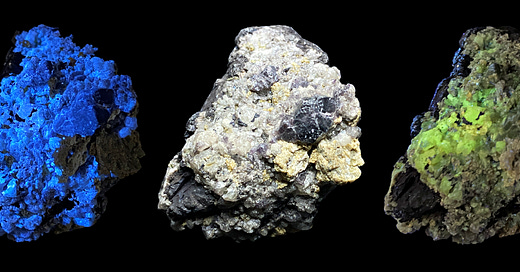The mineral scheelite normally fluoresces a bluish white under a shortwave ultraviolet light source. Occasionally, a yellowish response will occur under longwave.
Why is this so?
Scheelite is a calcium tungstate mineral with the chemical formula CaWO4. It is known for its fluorescent properties, particularly under shortwave ultraviolet (UV) light, where it typically emits a bluish-white glow (most common activator: WO42-).
The occasional yellowish fluorescence under longwave UV light can be influenced by the presence of impurities within the scheelite crystal structure. Molybdenum, often in the form of powellite (CaMoO4), is one such impurity that can affect the fluorescent properties of scheelite. Its most common activator is MoO42-.
Here's how molybdenum might influence the fluorescence of scheelite:
Substitution in Crystal Structure: Molybdenum can substitute for tungsten in the scheelite crystal lattice due to their similar ionic radii and chemical properties. This substitution can alter the electronic structure of the mineral, affecting its fluorescent response.
Energy Levels: The presence of molybdenum can introduce different energy levels within the crystal structure. These energy levels can influence how the mineral absorbs and emits light, leading to variations in fluorescence colour.
Activators and Quenchers: In fluorescent minerals, certain elements can act as activators, enhancing fluorescence, while others can act as quenchers, reducing it. Molybdenum might act as an activator for a different wavelength of light, causing the yellowish fluorescence under longwave UV.
Concentration Effects: The amount of molybdenum present can also affect the intensity and colour of fluorescence. Higher concentrations might lead to more pronounced changes in the fluorescent response.
Of course, it could be something completely different! If you have any other suggestions, please let me know.
Below: Scheelite on ferberite, Wolfram Camp, Queensland. 32x30x20mm. Shown under shortwave (left), white light (centre) and longwave (right). Note that this is an old photo and the shortwave response is not that blue!





Thanks Steve, I always learn so much from your articles. Remember looking for scheelite and malayite around Meldon quarry, Dartmoor, Devon with short wave. We found loads of fluorescent material which were soft and pellet shaped… Yes, rabbit droppings!